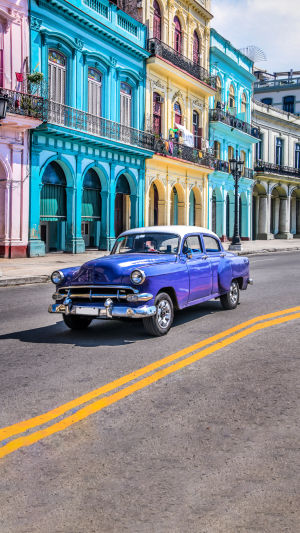Havana, the capital and largest city of the Republic of Cuba stands as the gateway from the Gulf of Mexico to the Atlantic Ocean.
If you want to catch a glimpse of cars produced in the United States during the 1950s, aside from visiting specialized vehicle museums, your best bet is usually through occasional appearances in movies.
However, the scenario is quite different in Cuba, nestled in the Caribbean.
Cuba proudly boasts the world's largest collection of classic cars, with the streets of Havana serving as a nostalgic showcase.
The city's thoroughfares are teeming with vintage automobiles from the 1950s, lending an unmistakable retro vibe to the surroundings.
These aged vehicles confidently navigate the streets, seamlessly blending with the weathered architecture of the old city, creating a vivid impression of a journey back in time.
Strolling through the streets of Havana, one is consistently accompanied by these classic cars. Their exhaust occasionally billows out black smoke, and their engines roar as they speed away.
Adorned with an array of flamboyant car paints, the cars exude a cool, if somewhat exaggerated, aura. Walking through the city feels like stepping into a time tunnel, a sentiment that has attracted many filmmakers for nostalgic Hollywood blockbusters.
As brightly colored classic cars swiftly pass by, there's scarcely enough time to closely examine them, leaving you captivated by the ageless atmosphere that Havana effortlessly imparts. The city's charm becomes irresistible, making it difficult to break free.
These vintage cars share common traits—a lengthened and widened exterior, coupled with sizable tires. While they often roam Havana's streets with the primary goal of attracting customers for driving tours, this doesn't diminish the allure they hold for those who quietly appreciate their nostalgic charm.
The preservation of classic cars in Cuba is not merely fueled by sentimental attachment but is a necessity of life.
Cubans, driven by ingenuity, assume the role of mechanical experts to maintain the original body, engine, and accessories while implementing necessary modifications. This resourcefulness ensures the longevity of these classic cars, preserving their form and function.
The unique existence of a classic car serves as a testament to the prosperity of the past. Despite the passing years, their brilliance remains undiminished, seemingly frozen in time with an enduring elegance.
Reports indicate that nearly 70,000 classic cars grace the streets of Havana, all produced between the 1930s and 1950s, featuring renowned brands such as Ford, Plymouth, Pontiac, Dodge, Chevrolet, and more.
Today, these classic cars have unintentionally become a captivating attraction in Cuba's tourism industry. In the eyes of many, the classic cars that grace the streets of Havana stand as a moving spectacle impossible to ignore—a source of pure delight.





